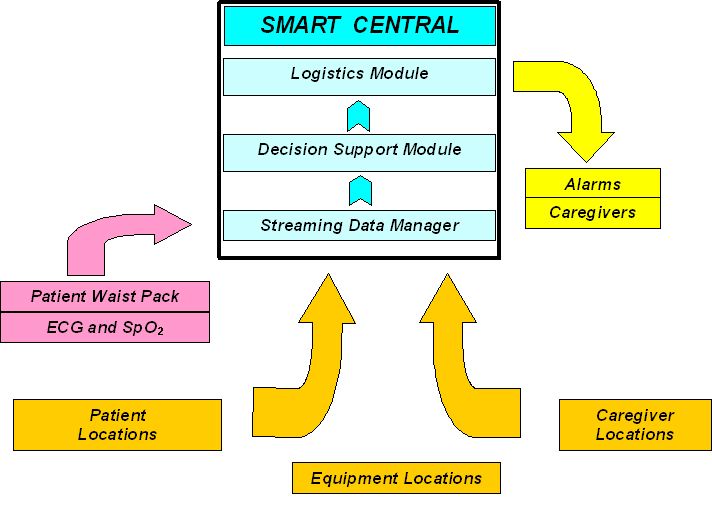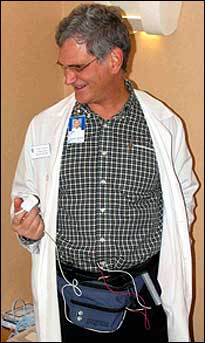
| Research Abstracts Home | CSAIL Digital Archive | Research Activities | CSAIL Home |
![]()

|
Research
Abstracts - 2007
|
SMART: Scalable Medical Alert and Response TechnologiesDorothy Curtis, Esteban Pino, Jacob Bailey, Lucila Ohno-Machado, Robert Greenes & John GuttagIntroductionThe Scalable Medical Alert and Response Technology Project (SMART) [1] is examining the deployment of advanced technology in the waiting area of an Emergency Department to wirelessly monitor vital signs and locations of otherwise unattended patients. This gives waiting patients some security that their condition is being monitored even though a caregiver is unavailable. The Emergency Department caregivers are alerted to problems occurring in the waiting room in real-time and patient priorities can be dynamically adjusted depending on the circumstances. ApproachDuring the past few years we developed a prototype of the SMART system. The prototype includes a handheld computer for the patient that has two sensors. The sensors, which monitor the electrical rhythms of the heart (ECG) and the oxygenation levels (SpO2), send their data to the patient's handheld. The handheld forwards the data to a central server. The central server monitors the signals and alerts appropriate caregivers when there is a problem. The system also has an indoor positioning system manufactured by Sonitor [2], for locating patients, caregivers, and equipment. With this prototype, we can monitor patients who complain of shortness of breath or chest pains and who seem likely to spend a not insignificant amount of time waiting to see a caregiver. ArchitectureThe data flows from the patients' sensors to the patients' PDAs to the SMART Central Computer, as shown in Figure 1.
 Figure 1: SMART System Architecture ProgressDuring the past year we deployed our prototype system: we have eight SMART Patient Waist Packs with sensor boxes and location tags, two caregiver PDAs and a SMART Central computer located in the waiting area of the Emergency Department at the Brigham and Women's Hospital in Boston. Figure 2 shows one of our SMART colleagues wearing a SMART Waist Pack.
 Figure 2: SMART Colleague with SMART Waist Pack We have monitored over 110 patients since mid-June 2006. For three of these patients this monitoring indicated significant problems and the paramedic who operates the SMART system called this to the attention of the caregivers and these patients were seen immediately. We have also collected about 100 hours of data. In September 2006, we participated in Operation Poseidon, a large-scale preparedness exercise in the Boston area that incorporated several disaster sites, many volunteer victims, local police and fire departments, several ambulance services and several local hospitals. A laptop-based SMART Central was set up quickly, in about 5 minutes. We then monitored six unconscious patients who arrived at the Brigham and Women's Hospital. FutureWe are currently working on various aspects of scalability of the SMART system. The first is sending vital signs and GPS data from an ambulance for display on a SMART central computer. The second is aspect is simulating the use of SMART systems in large scale disasters. Research SupportThis research is supported by the National Library of Medicine, contract number N01LM33509. Various publicity, largely courtesy of Terry Aasen of Sonitor. Thanks! News articles References:[1] Lucila Ohno-Machado and Dorothy Curtis. Smart: Scalable Medical Alert and Response Technology. [2] Sonitor Technologies: Indoor Positioning System. [3] Jason Waterman, Dorothy Curtis, Michel Goraczko, Eugene Shih, Pankaj Sarin MD, Esteban Pino, Lucila Ohno-Machado MD, PhD, Robert Greenes MD, PhD, John Guttag PhD and Thomas Stair MD. Demonstration of SMART (Scalable Medical Alert Response Technology). Presented at AMIA, Washington, D.C., October 2005. [4] Esteban Pino, Lucila Ohno-Machado MD, PhD, Eduardo Wiechmann PhD, and Dorothy Curtis. Real-Time ECG Algorithms for Ambulatory Patient Monitoring. Presented at AMIA, Washington, D.C., October 2005. [5] Operation Poseidon Link 1 Link 2 Link 3 |
||||
|